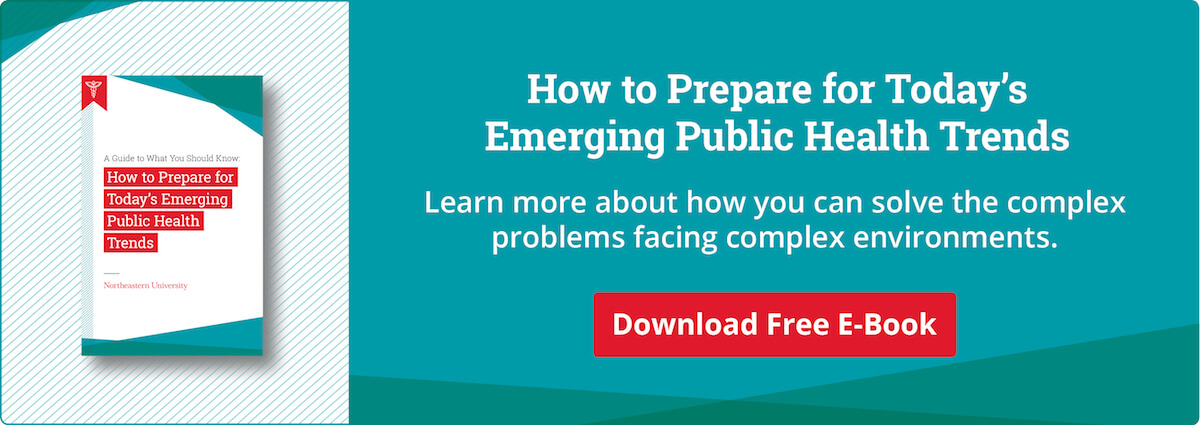Smoking has been proven to increase the risk for a number of different cancers and chronic illnesses, but many other health problems lack such a direct, biological cause. In some cases, certain populations across and within countries, cities, and even neighborhoods experience a significantly higher burden of diabetes, infant mortality, obesity, and other preventable health conditions. In the U.S., infants born to black women have 2.3 times the infant mortality rate of non-Hispanic, white infants. This variance is likely the result of both social and biological factors that impact health not just during pregnancy, but long before it. It’s one example of a health inequity—an avoidable gap in health among groups of people caused by social, economic, environmental, and even geographical factors.
Download Our Free Guide to Preparing for a Career in Public Health
Learn more about how you can solve the complex problems facing complex environments.
What Causes Health Inequities?
The root causes of health inequities run deep, making their resolution a complex but critical effort that begins with careful examination of a community’s social, economic, and political circumstances.
“We need to go as far upstream as possible and look at the structural elements of a community,” says Neil Maniar, professor of practice and director of the Master of Public Health program at Northeastern.
Access is a critical factor in understanding the causes of health inequities. Maniar points to healthy and affordable nutrition, places to exercise and walk, and culturally appropriate healthcare as key access points for communities. Zoning laws that make it easier for a fast food restaurant to open up than a farmers market, for example—and a community’s ability to gather the necessary resources to fight that decision—also play a role.
Lack of access can often be traced back to structural racism and discrimination, according to a 2017 report from the National Academies of Sciences, Engineering, and Medicine. As more resources are diverted to affluent, often predominantly white areas, others struggle to meet the basic needs of their residents or enact and implement stronger educational, health, and safety resources.
“We have to think of not just economic capital in a neighborhood, but political and social capital in a neighborhood, and how they all come together, too,” Maniar says.
The Effects of Health Inequities
Inequities impact more than the communities in which they exist, creating financial and social ramifications felt far beyond those borders. According to the National Academies’ report, eliminating health disparities in the U.S. would have saved nearly $300 billion in medical expenditures between 2003 and 2006.
“We are continuing to deploy resources in a way that may not have the greatest impact,” Maniar says. “If we better understood what’s driving these disparities, we could focus on those interventions that we know are going to have a sustainable impact. There’s always a need to have continued research and evaluation.”
Socially, health disparities take away from the vibrancy of communities. According to a study conducted by experts and professors at New Zealand’s Department of Public Health and Harvard University’s School of Public Health, reducing health inequities may lower the possibility of violence in families and larger social conflict while improving education and participation in local government. This is largely because, instead of focusing on health concerns and the many stresses that accompany them, families with fewer inequities can spend their energy on building community and addressing other areas of need.
Closing the Gap
Eliminating health disparities is a monumental task that requires the implementation of new federal and local laws, programs, and funding. Maniar points out that the Affordable Care Act, in particular, has made access to preventive healthcare easier for individuals while also helping build out infrastructure surrounding community health centers. The fastest way to address inequities, though, is through community-based efforts.
“There’s a continued need to give communities the resources needed so that they can effectively advocate for themselves,” Maniar says. Non-profit hospitals have played a vital role in filling this need by conducting community health assessments every three years. These mandatory reports highlight areas for improvement within surrounding neighborhoods and often form the basis of new community health programs.
When local efforts like these take hold, communities thrive. For example, since the Dudley Street Neighborhood Initiative’s founding in 1984, dozens of home and community gardens have been established in the Boston neighborhood. The program has also successfully developed youth leaders, researched trends in public health and access, and provided affordable housing that prioritizes community control over development. Thanks to the impact of these initiatives, the organization has become heavily involved in city planning measures that will affect housing and community wealth across Boston in the next 10 years.
As communities continue to advocate for change, professionals who understand how to best support them will find ample opportunity to make a difference. Northeastern’s Master of Public Health program has a primary focus on urban health, health equity, and social justice and provides students with real-world experience in how to approach these important concepts. Their real-world experiences, combined with classroom instruction and a capstone project, provide a comprehensive foundation that enables students to effectively and sustainably address some of our most pressing public health challenges.
“We really teach students how to address complex problems in complex environments by understanding not just social determinants of health, but social justice frameworks and the impact of racism and discrimination, too,” Maniar says. “This entire issue is a core focus of our curriculum.”







Related Articles
Jackney Prioly Joseph on How Her MPA Helped Her Career
Master’s in Nonprofit Management vs. Public Administration
How an MPH Clarified One Alumna’s Career Path